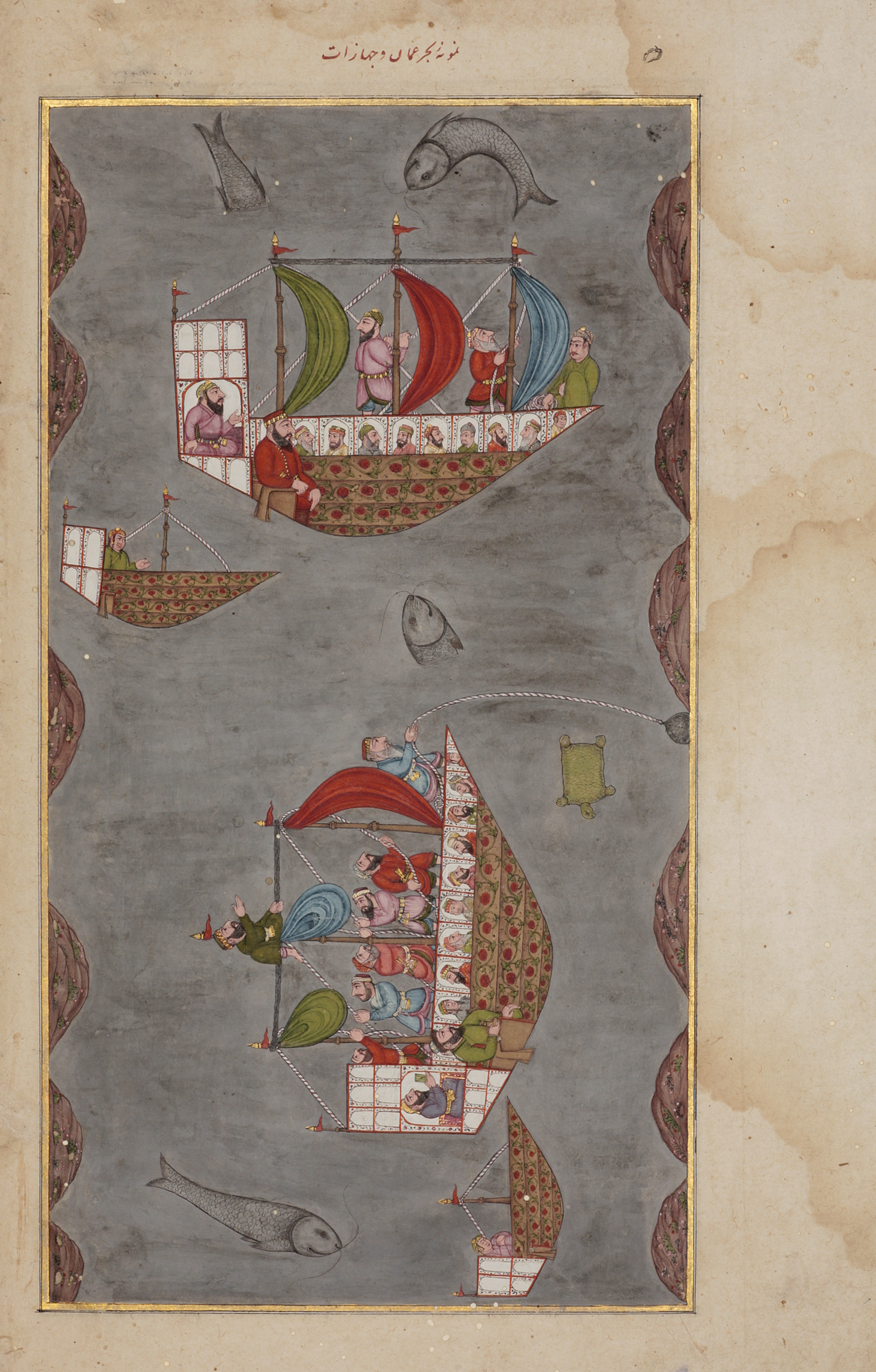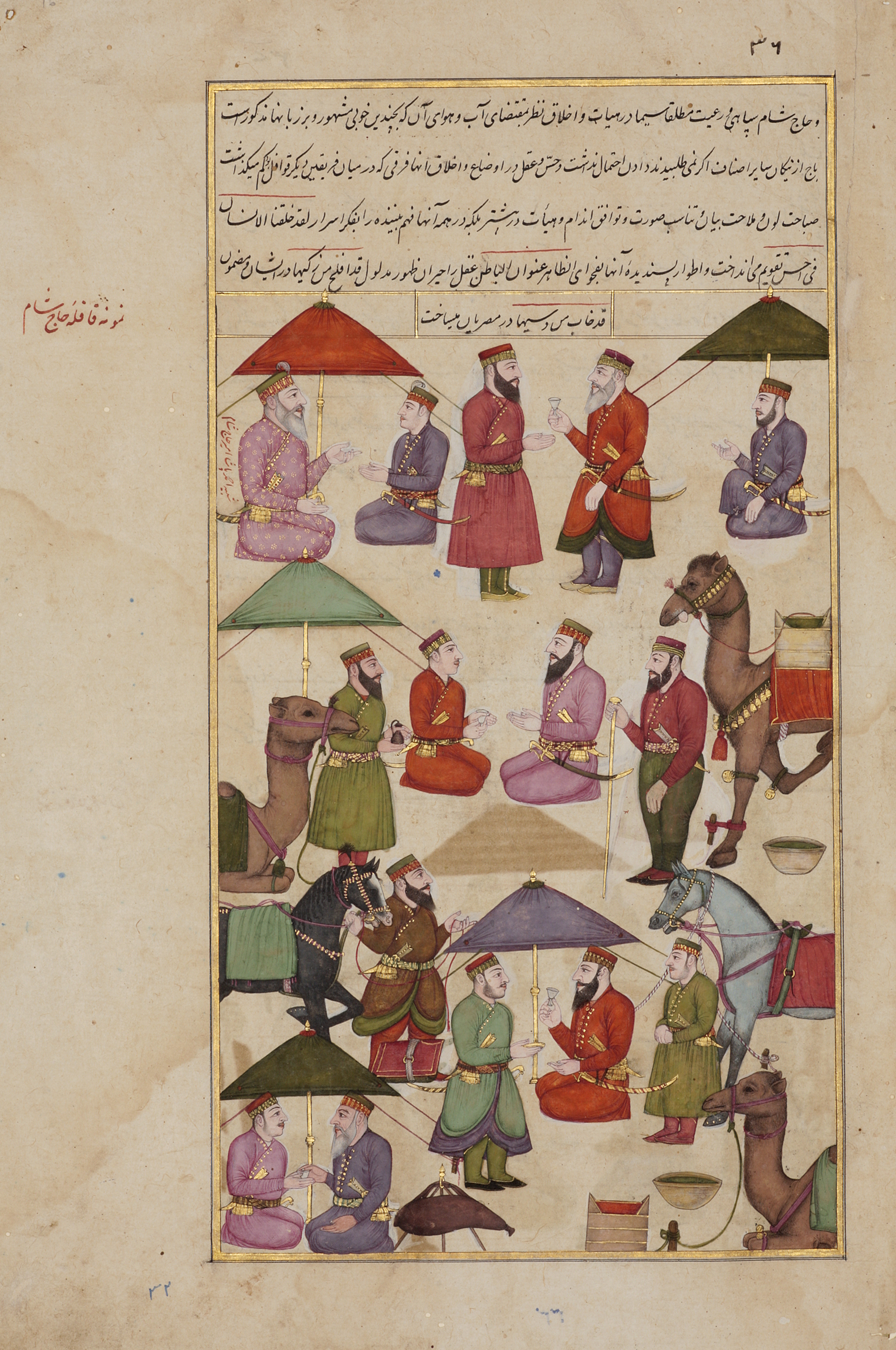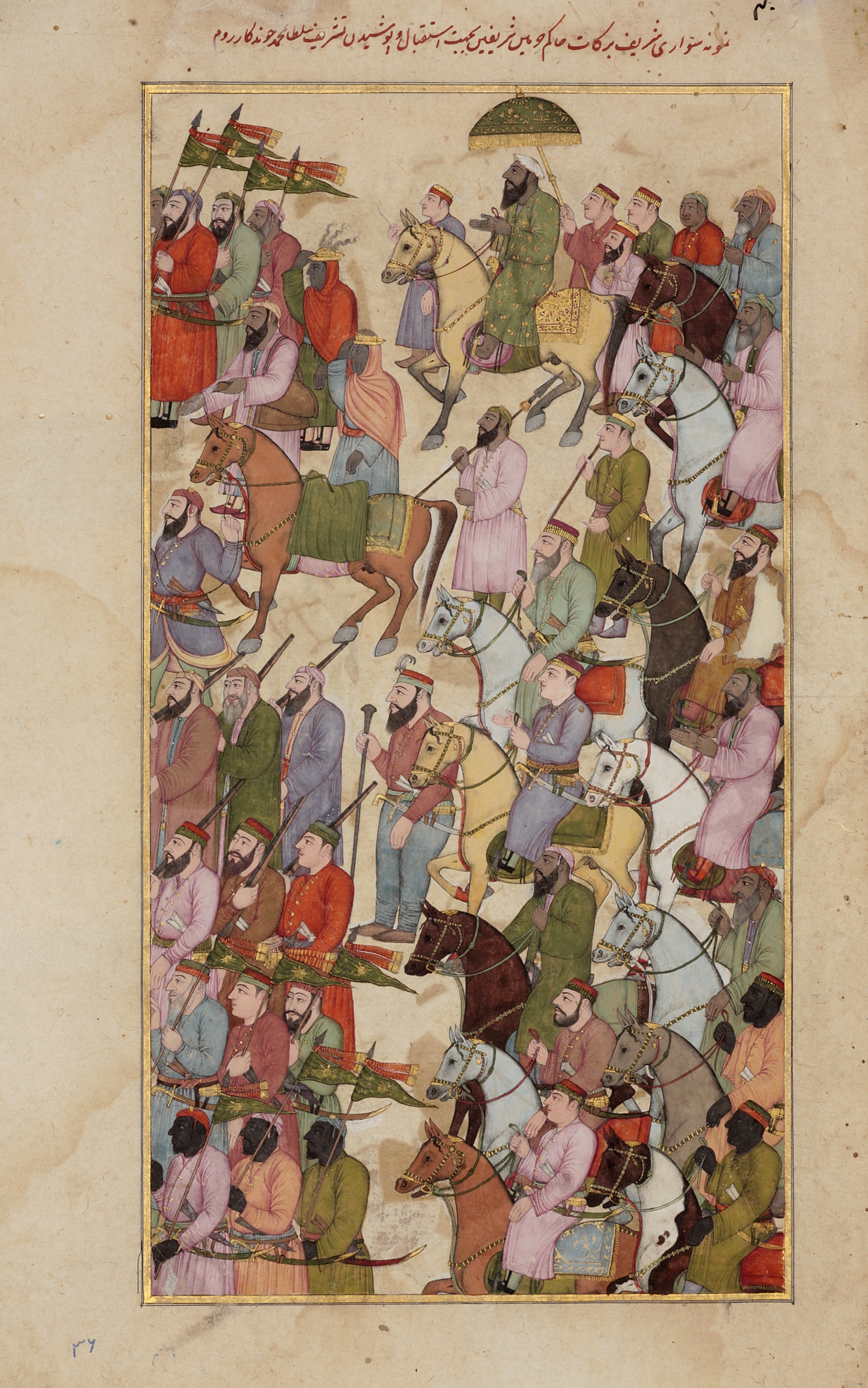Safi ibn Vali’s Anis al-Hujjaj (‘Pilgrims’ Companion’)
Location: possibly Gujarat, India
Materials: ink, gold and opaque watercolour on paper; modern leather binding
Dimensions: 23 folios, with 11 full-page and 9 half-page illustrations; 33 x 23.2cm (page); 27.4 x 14.7cm (text panels, and full-page illustrations)
Accession Number: MSS 1025
Other Notes:
Written during the year-long pilgrimage undertaken by the author, Safi ibn Vali, in 1676–77, the Anis al-Hujjaj (‘Pilgrims’ Companion’) gives advice to prospective pilgrims on every aspect of the journey: which ships to choose, how to stay healthy, the places to visit, the rituals to be observed and the people one is likely to encounter. Safi ibn Vali’s own pilgrimage (he commenced his journey on 12 Rajab 1087/ 20 September 1676) was made possible through the financial help of Zib al-Nisa, a daughter of the Mughal emperor Awrangzeb, for whom he had written a commentary on the Qur’an.
This manuscript belongs to a long-established tradition of guides to the Holy Places (see MSS 1038), although the illustrations here differ in that they combine the diagrammatic views normally found in such guides with vivid and colourful scenes of the pilgrims and their caravans. The illustrations are simple in their conception yet their attention to detail is acute. They provide a cogent picture of camp life of pilgrims in the late 17th century.
The illustrations
- View of the port of Surat and the ships carrying pilgrims (folio 2b). Surat, on the Western coast of India, north of Bombay, was one of the main points of departure to Arabia. The view is oriented to the south.
- The pilgrims’ ships crossing the Sea of Oman (folio 3b). The two larger ships carry pilgrims; one, on the right, appears to be casting (or raising) anchor. The smaller vessels may be fishing boats.
- The mish‘ar al-haram and the ritual of collecting pebbles (folio 10a). The painting shows the pilgrims in the region of Muzdalifa, in a state of ihram (ritual purity), collecting pebbles.
- The pilgrims in the town of Mina, being shaved, making sacrifices and casting pebbles at the Devil (folio 10b). This day corresponds to ‘Id al-Adha on 10 dhu’l-Hijjah, the feast commemorating the Sacrifice of Abraham. By this stage, the pilgrims, who are in a full state of ihram indicated by their white garments, have already completed their initial circumambulation of the Ka‘bah (the welcome tawaf); the ritual of running between the hills of Safa and Marwa (sa‘iyy) recalling Hagar’s desperate search for water for her son Isma‘il; the day of prayer at ‘Arafat – a most holy time when every pilgrim stands alone with God; and the gathering of pebbles at Muzdalifa in preparation for the stoning of the Devil at Mina. This recalls yet another chapter in the Abrahamic narrative in which Isma‘il stones the Devil seven times (the ritual is illustrated in the upper right-hand corner of the painting). After this a sacrifice is made. The pilgrims are released from most of the restrictions imposed by the state of ihram; men shave their heads and beards; women have their hair clipped. Pilgrims can now wear their normal clothes and leave for Mecca, where they perform another essential rite, a further circumambulation of the Ka‘bah known as the tawaf al-ifadah, which takes place on the same day.
- The birthplaces of the Prophet Muhammad; Fatimah; Abu Bak al-Siddiq; as well as the Madrasah of Sultan Sulayman, and a Bektashi lodge (folio 11b). These are shrines to visit in the vicinity of Mecca, which are not part of the hajj rituals.
- Plan of the Masjid al-Haram in Mecca with the Ka‘bah (folio 12a).
- The camp of North African caravan of pilgrims (folio 15a).
- The camp of Egyptian caravan of pilgrims (folio 15b).
- The camp of the Syrian caravan of pilgrims (folio 16a). Unlike the pilgrims from North Africa and Egypt, the Syrian pilgrims are richly dressed and carry swords and gold daggers. Ahmad Pasha, the Syrian Amir al-Hajj, is identified by a caption (top left).
- The camp of the desert Arabs and the people of Najd (folio 16b).
- The camp of the caravans of the Indian (top) and Iranian pilgrims (folio 17a).
- Officials, scribes and secretaries (folio 17b). This is a small illustration, which is not captioned.
- Sharif Barakat, hakim haramayn sharifayn (‘Governor of the two Holy Sanctuaries’), riding to meet the envoy of Sultan Mehmed [IV], the Emperor of Rum (folio 18a).
- ‘Abdi Pasha, the Amir al-Hajj of the Egyptian caravan, on his way from Mecca to Medina (folio 18b).
- The port of Mucha, in the Yemen (folio 21a). The illustration shows the pilgrims’ ships departing from the port as well as Sayyid Husayn, the Governor of Mucha, riding his horse (bottom right).
- The port of Jeddah (folio 22b). This view is very similar to that of Mucha (folio 21a) in that it combines views of the city and the pilgrims’ ships with one of the Governor of the city, Sunjuq.
- Man attacked by a lion (folio 21b); Man saved from the jaws of a lion (folio 23a); A feast (folio 23b). The three small-scale paintings are illustrations to a parable about a very poor woman taking pity on some beggars passing by and feeding them; her act of generosity was rewarded when a stranger saved her son from being eaten by a lion. The feast is probably in celebration of the son’s safe return to his mother.
Script:
Persian text copied in nasta‘liq; with 23 lines to the page
Bibliography:
L. York Leach, Paintings from India, The Nasser D. Khalili Collection of Islamic Art, volume VIII, London 1998, cat.34, pp.124–9.
J.M. Rogers, The Arts of Islam. Masterpieces from the Khalili Collection, London 2010, cat.332–41, pp.284–7.
















 Print Page
Print Page
 Print Page
Print Page















